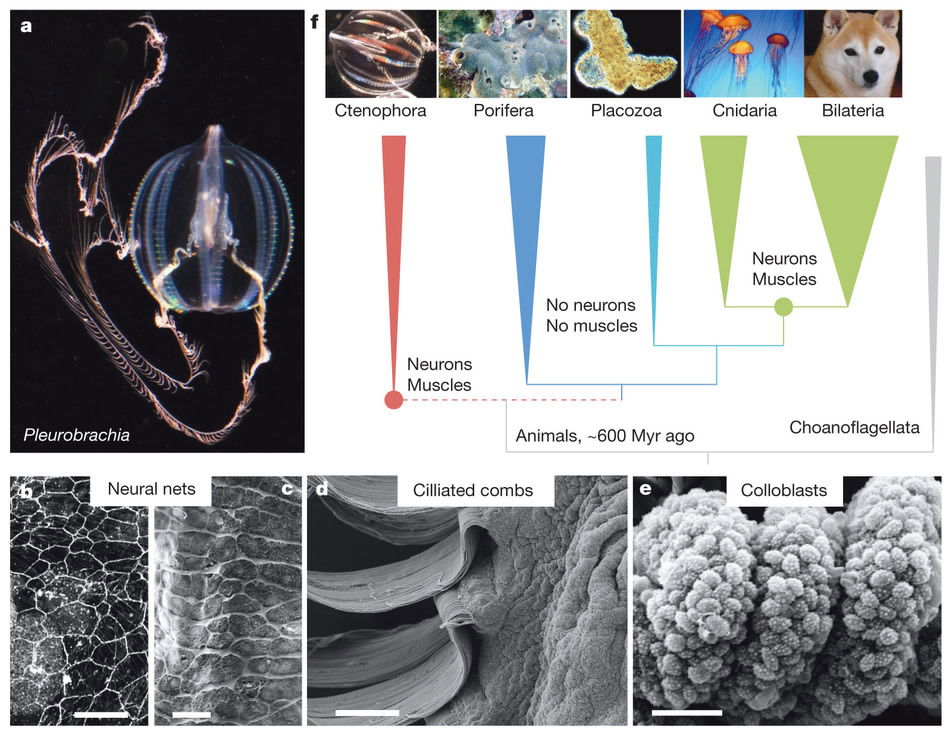
Comb Jelly Genome Mystery Generates Confusion
News to Know
Abstract
Jelly genome shakes the evolutionary tree of life to its roots.
News Source
- National Geographic: “Strange Findings on Comb Jellies Uproot Animal Family Tree”
- Nature: “Jelly Genome Mystery”
The Pacific sea gooseberry (Pleurobrachia bachei) threatens to uproot the evolutionary tree of life. Many evolutionists believe such comb jellies represent our earliest evolutionary cousins, the first multicellular animals to evolve. Far from shedding light on the earliest animal to evolve, however, researchers have discovered the comb jelly’s simple complexity is too divergent for comfort.
Reporting on the mismatch between its simple genome and inexplicably complex characteristics in Nature, they suggest these animals evolved along a completely different path from the rest of the animal kingdom. Neurobiologist Leonid Moroz, lead author of the “The ctenophore genome and the evolutionary origins of neural systems,” calls these comb jelly misfits “aliens of the sea.”
First Animals
Appearing deep in the fossil record—in rock layers conventionally dated 500 million years ago—the comb jelly is believed by evolutionists to have appeared very early on the tree of life. But its unconventional “early” complexity paradoxically combines with a lack of genes thought essential for all animals to create several mysteries. “Everyone thinks this kind of complexity cannot be done twice,” Moroz says. “But this organism suggests that it happens.” Whether the first multicellular animal was a sponge, a placozoan, or a comb jelly remains a matter of debate among evolutionists. In their evolutionary view, the most primitive animal should be very simple. Each contender—sponge, placozoan, and comb jelly—possesses phenotypic or genomic complexity out of keeping with an evolutionary basal organism. Sponges and placozoan’s have no nerve or muscle cells. The comb jelly does, but its genome is missing so much of what other animals have that evolutionists debate whether it evolved first or evolved later and suffered “massive gene loss that mimics a simple genome.”1
None of these animals is really simple or primitive, but they remain the leading candidates for “first animals.”
Sponges are able to move without neurons or muscle cells, and scientists are still trying to figure out how their contractile skin-like cells function and fit into evolutionary patterns. Placozoans—flat ciliated “sticky hairy plates”—move along marine surfaces oozing out enzymes to digest algae. Yet despite their simple body plan, the placozoan genome is as complex as ours. Conversely, the comb jelly’s neurological complexity is unexplained by its simple genome. None of these animals is really simple or primitive, but they remain the leading candidates for “first animals.”

In the upper left is a comb jelly—specifically a Pacific sea gooseberry, Pleurobrachia bachei. Comb jellies have eight combs of interlinked cilia. Looking like a jellyfish but having glue-secreting cells instead of stinging cells, many have classified the comb jelly as a sister to the jellyfish (cnidaria). Since the advent of genomic study, many evolutionists now think the comb jelly branched from the animal tree of life much earlier, even before the phenotypically less-complex sponges and placozoa. Comb jellies (ctenophora), sponges (porifera), and placozoa (sticky hairy plates) are all contenders for the earliest evolved animal, as indicated in the chart (upper right). Sponges and placozoa have no nerve or muscle cells; comb jellies do, but have simpler genomes. Shown in the bottom images (left to right) are some of the complex designs found in comb jellies—their neural nets, ciliated combs, and glue-secreting colloblast cells in the tentacles. (scale bars, left to right, 60μm, 20μm, 100μm, 20μm) Image by Leonid L. Moroz et al., via Nature.2
Simplicity Cloaked in Complexity and Confusion
Though brainless, the comb jelly’s net of nerve and muscle cells draped symmetrically around gravity and light sensors directs eight combs of interlinked cilia to propel it through the water and to rake in its dinner. Yet the Pacific sea gooseberry’s genome, along with that of one other comb jelly species (Mnemiopsis leidyi), confirms that much of the “standard equipment” for multicellular animals is missing. How this complex nervous system functions is a mystery. How the comb jelly embryo’s stem cells “know” how to differentiate is a mystery. How the comb jelly regulates expression of the comparatively small number of genes it has is a mystery.
When the comb jelly Mnemiopsis leidyi was sequenced last year, scientists found enough genes in common among the “simplest” of earth’s animals to prompt them to suggest the ancestor of these animals evolved a fair amount of complexity and then each of the “early” animals—sponge, placozoan, and comb jelly—lost complexity. The comb jelly genome had tangled the tree of life at its roots, and the latest jelly genome mystery has done nothing to clarify matters. Moroz and colleagues write, “Ctenophores [comb jellies] and their genomes present matchless examples of ‘experiments’ in nature and the possible preservation of ancient molecular toolkits lost in other animal lineages.”3
Missing Essentials
The radially symmetrical comb jelly is most remarkable for its functional complexity despite what it is missing. It lacks the microRNAs that regulate gene expression in other animals. It has no discernible immune system. It has no Hox genes, which guide the layout of the body plan in bilaterally symmetrical animal embryos. Though it has a nervous system with neurons, it lacks the genes that trigger neuron differentiation in the embryos of other animals.
The phenotypic-genotypic mismatch is most apparent in the nervous system. The comb jelly is missing genes for eight of the ten primary neurotransmitters found in all other animal nervous systems. But though it lacks the ability to manufacture diverse neurotransmitters, the comb jelly’s neurons, researchers say, “evolved an enormous diversity of electrical synapses.”4 The comb jelly’s neurological complexity is reflected in its predatory behavior and daily migratory patterns. How does it do so much with such a small genetic toolkit?
Viewing the comb jelly’s “key molecular innovations underlying neural organization”5 as “remarkable examples of convergent evolution,”6 Moroz et al. write, “Evidently, with a markedly different molecular and genomic make-up, ctenophores have achieved complex phenotypic plasticity and tissue organization.”7 Moroz says, “It’s a paradox. These are animals with a complex nervous system, but they basically use a completely different chemical language.”
Moroz’s team and others propose that nervous systems evolved twice—one way for comb jellies and another for all other animals. Where to place sponges and placozoa on this evolving tree of life is an additional point of contention. Nature’s columnist, commenting in “Excitation over jelly nerves,” concludes, “The development and evolution of the complex nervous system of these creatures will be an enigma for some time. If it turns out that comb jellies are not at the base of the tree and that animal neurons indeed originated only once, someone must figure out why the molecular biology underlying the comb-jelly nervous system is so different from that of other animals.”8
Mysteries Worth Solving
Someday, learning how the comb jelly’s embryonic stem cell differentiation is directed will add to our understanding of the repertoire of God’s design for pluripotent cellular differentiation. Someday, learning how comb jelly gene expression is regulated without microRNAs will improve our understanding of the ways genes work. Someday, learning how comb jelly neurons communicate with each other despite their paucity of neurotransmitters will doubtless improve our understanding of neuroscience.
None of these solutions, however, will reveal the origin of comb jellies or identify the first multicellular animal. In fact, the origin of the first animals is not a mystery that can be solved by scientific observation. We instead have a historical record that reveals this information. God our Creator has provided us an eyewitness account of animal origins. From the Bible we learn that God created all kinds of animals during Creation Week about 6,000 years ago. The study of living things reveals that organisms reproduce and vary within their created kinds. This scientific observation is consistent with God’s Word. While many living things made by our Common Designer feature common designs, the origin of unique and unusual designs like the repertoire in the comb jelly is no evolutionary mystery but rather an example of God’s creative design.
Further Reading
- Comb Jelly: World’s Most Primitive Animal?
- Sea Sponges Challenge Traditional Evolutionary View of How Oceans Became Oxygenated
- Sponges Squeezed Out of First Place
- Sea Anemone’s Genome Said to Show Evolutionary Root of Plants and Animals
- A Tale of Shale and Oxygen in the Explosion of Life
For More Information: Get Answers
Remember, if you see a news story that might merit some attention, let us know about it! (Note: if the story originates from the Associated Press, FOX News, MSNBC, the New York Times, or another major national media outlet, we will most likely have already heard about it.) And thanks to all of our readers who have submitted great news tips to us. If you didn’t catch all the latest News to Know, why not take a look to see what you’ve missed?
(Please note that links will take you directly to the source. Answers in Genesis is not responsible for content on the websites to which we refer. For more information, please see our Privacy Policy.)
Footnotes
- Andreas Hejnol, “Excitation over Jelly Nerves,” Nature 510 (June 5, 2014): 38–39, doi:10.1038/nature13340.
- Leonid L. Moroz et al., “The Ctenophore Genome and the Evolutionary Origins of Neural Systems,” Nature 510 (June 5, 2014): 109–114, doi:10.1038/nature13400.
- Ibid.
- Ibid.
- Ibid.
- Ibid.
- Ibid.
- Hejnol, “Excitation over Jelly Nerves.”
Recommended Resources

Answers in Genesis is an apologetics ministry, dedicated to helping Christians defend their faith and proclaim the good news of Jesus Christ.
- Customer Service 800.778.3390
- © 2024 Answers in Genesis




